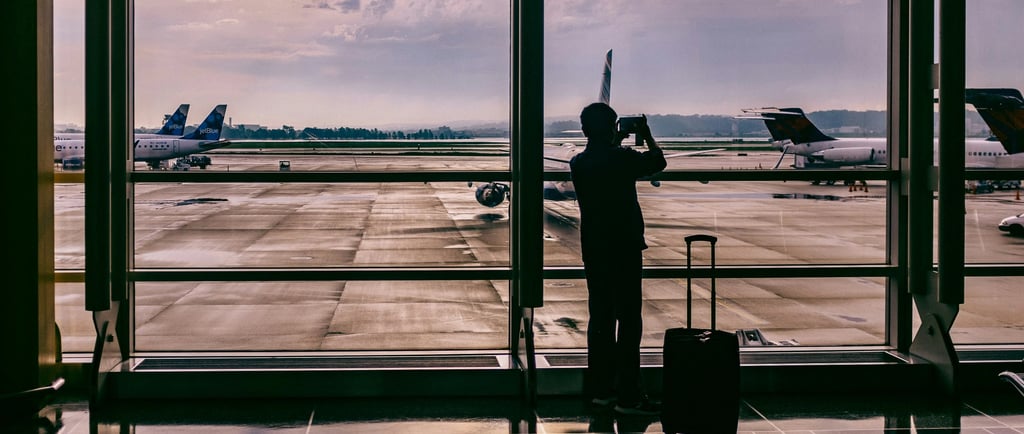Carry-On Luggage Sizes: Airline Guide 2025
Discover 2025's airline carry-on luggage sizes. Avoid fees with our comprehensive guide to carrier bag dimensions and measurements.
Deepika
7/5/20253 min read


When you're packing for a trip, nothing is more frustrating than arriving at the airport only to be told your bag is too big to carry on. You either pay unexpected baggage fees or scramble to rearrange items on the spot. The truth is, carry-on luggage sizes vary widely between airlines, and staying within the limits can save you time, money, and stress.
In this guide, we break down standard luggage carry on measurements, airline-specific rules, and tips to help you travel smarter. Whether you're a frequent flyer or planning your first trip, this blog will help you pick the right carrier bag size and avoid common packing mistakes.
Standard Carry-On Dimensions
Most airlines stick to a general size guideline for carry-on luggage. However, this isn’t universal, and there are subtle variations that can cost you dearly if you’re not prepared.
Typical Carry-On Size Limit:
22 x 14 x 9 inches (56 x 36 x 23 cm) – including handles and wheels.
This is considered the standard size for carry-on luggage in the U.S., and many international airlines also follow this guideline. That said, some budget carriers have stricter rules, so always double-check.
Tip: Use a soft measuring tape to confirm your bag’s size after it’s packed, as clothes and items can expand it beyond the limits.
Why Size Matters
You might wonder—what's the big deal if your bag is just an inch or two over?
Here's what could happen:
Additional Fees: Some airlines charge $50+ to check a non-compliant bag at the gate.
Flight Delays: Overhead bins fill up fast. If your bag doesn't fit, it slows down boarding.
Inconvenience: You’ll be separated from your belongings and may wait longer at baggage claim.
By sticking to the allowed luggage carry on measurements, you can breeze through security, avoid delays, and keep essentials close.
Personal Item vs. Carry-On: What’s the Difference?
Many travelers often confuse personal items with carry-on bags, but they serve different purposes and follow separate rules. Let’s break it down so you know exactly what to bring onboard.
What Counts as a Personal Item?
A personal item is a smaller bag meant to fit beneath the seat in front of you. Common examples include:
A small backpack
A laptop or briefcase-style bag
A handbag or tote
A compact camera case
It’s designed for things you’ll want easy access to during the flight, like electronics, travel documents, snacks, or a book.
Size Limits for Personal Items
Most airlines allow personal items up to around 18 x 14 x 8 inches, but this may differ. Some low-cost carriers—such as Spirit or Frontier—include only a personal item with your base fare and charge extra for a full-sized carry-on.
Travel Tip: If you're planning to fly with just a personal item, choose a soft-sided bag. It’s easier to slide under tight seat spaces, especially on smaller aircraft.
How to Pick the Right Carry-On Bag
Shopping for carry-on luggage? Don’t rely solely on the label. Just because a bag is marked as “carry-on” doesn’t mean it meets every airline’s requirements—especially when fully packed or expanded.
Key Features to Look For:
Dimensions that stay within 22 x 14 x 9 inches, including wheels and handles
Lightweight design, ideally under 7 pounds when empty
Expandable zippers that offer flexibility without exceeding size limits
Spinner wheels (4-wheel style) for smooth and easy airport navigation
Sturdy side handles and a spot for your ID tag for added convenience
Tip: Choose reliable brands known for airline-approved sizes, such as Travelpro, Away, or Samsonite—they’re traveler favorites for a reason.
Packing Hacks to Stay Within Size Limits
Even the right-sized bag can get flagged if it looks overstuffed. Here’s how to pack smarter:
1. Roll Your Clothes
Rolling instead of folding not only saves space but also reduces wrinkles.
2. Use Packing Cubes
They compress clothing and keep your bag organized. You can even color-code for different types of clothing.
3. Wear Bulky Items
If you're bringing boots or a puffer jacket, wear them on the plane to free up space.
4. Limit Toiletries
Stick to travel-size bottles under 3.4 oz and pack them in a clear ziplock bag to save room and breeze through security.
5. Leave Room for Souvenirs
Don’t pack your bag to the brim—leave a little space for items you’ll pick up on your trip.
Conclusion
Understanding the right carrier bag size and airline rules can be the difference between a smooth trip and a stressful one. With each airline having its own version of what counts as a carry-on, taking the time to check the dimensions and pack accordingly is key.
Stick to the recommended luggage carry on measurements, pack light, and always double-check your airline’s latest policy. That way, you’ll avoid delays, save money, and enjoy a hassle-free travel experience.
Ready to fly smarter? Bookmark this guide and refer to it before every trip!
DuoNomadS
Follow us on
© 2025. All rights reserved.
MORE INFORMATION
REACH US